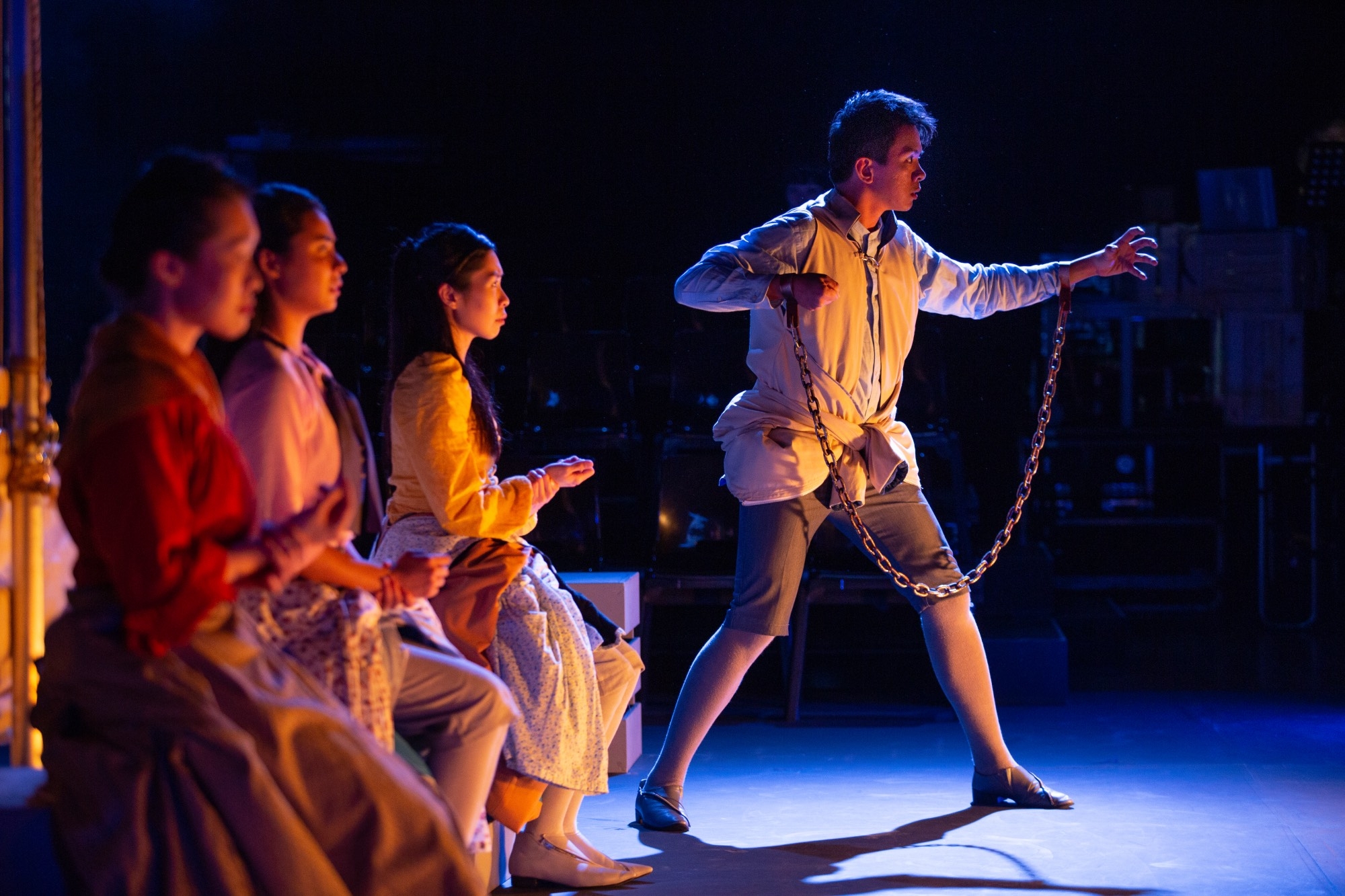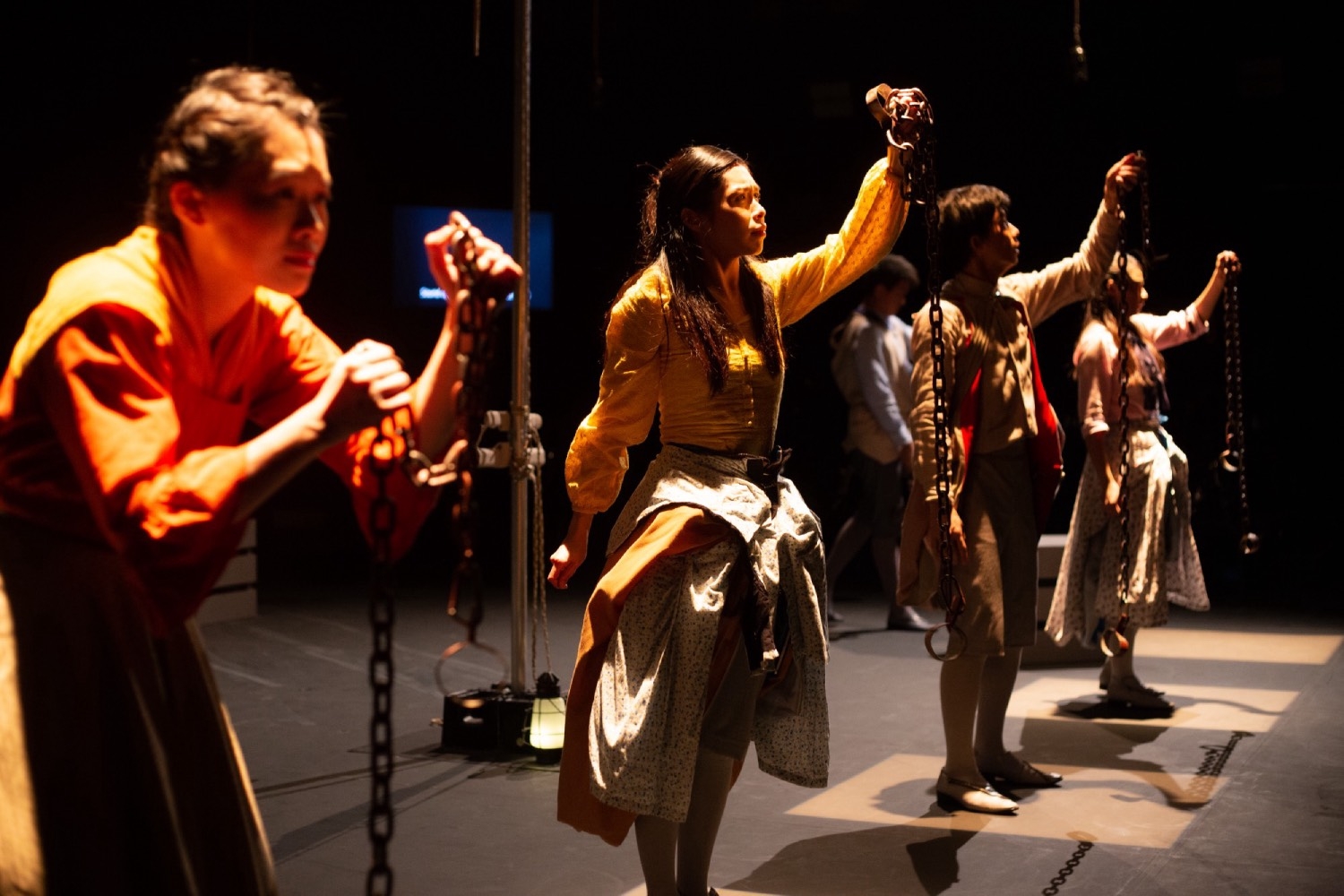Written by Cheryl Tan
Nine Years Theatre (NYT)’s First Fleet was presented in collaboration with the Singapore Chinese Cultural Centre. Inspired by Australia’s history of convict transportation, and most notably Thomas Keneally’s novel The Playmaker, Nelson Chia both wrote and directed First Fleet. Like last year’s production of Lear Is Dead, First Fleet also contains a play within a play. This time, we are told the story of how an officer aboard the fleet of the British Empire rehearsed a play with a group of convicts on their way to Australia with hopes of rehabilitation through theatre-making. This, coming from an officer whose only treatment of convicts would be one of disdain, you may think, is indeed something out of the ordinary — but then so was this entire production.
As soon as we stepped in we were ushered into seats lined up around a traverse stage. Stepped in where? In what seemed to be a regular blackbox space with a dark curtain hanging loosely at the back. “Seemed” because if there’s one immediate thing that First Fleet teaches us, it is that nothing really is as it seems. Reality can be distorted, warped, and redefined. If beauty lies in the eyes of the beholder, then perhaps realities lie in the tales of the storyteller.
This staging immediately tightened the sense of intimacy established between not just the audience with the story and characters, but also amongst audience members as we sat, occasionally glancing at each other from the sides or opposite ends. But before we go into the meta-theatricality of the play delivered by the character-actor (or, as Chia put it, ‘char-actor’), it is imperative to mention how immaculately the performance space was transformed solely by visual and sonic environment.

THE STORYTELLERS & THIER EXPERIENTIAL MAGIC
To start with, the play begins with sound. From the sides of the performance space we hear the slamming of heavy wooden carts on the floor. The actors emerge one by one, each carrying a wooden crate — slamming and picking them up as they went along, escalating in the creation of a steady, catchy rhythm. This scene was one of my personal favourites because of how flawlessly the movement sequence complimented the heavy, percussive sounds made by the slamming of the crates.
Throughout the play the characters interact and move around the set brilliantly designed by Lim Chin Huat (also the production’s movement coach). It comprised two metal poles extending from the floor of the performance space to the ceiling (or rigging, actually) upon which each hung two giant white sails. Around it lay several crates that the actors would use to sit and stand upon during the course of the performance. At first glance this may have looked like a simple set-up, but it displays a remarkable range of versatility, accommodating changes like the shifting of entire sails and the constant raising and lowering of sails — all of which successfully differentiate each scene and setting throughout the play.
From the moment we stepped into the space right to our exit after the performance, what particularly floored me was Ng Jing (Ctrl Fre@k)’s intricate line-up of sound cues. Ng’s does wonders in creating a sonic environment so attuned to the direction of the play that it was hardly noticeable at times, and therefore perfectly complementary. We were greeted by house sound cues upon stepping in, but what I remember most under detailed layers of audio was a very soft sequence of birds calling in the distance (alright, it was so soft I may or may not have imagined it). Playing percussive instruments live, Ng sounded with perfect timing the crack of whips and most notably, the creaking of the ships wooden floorboards — made with frequent and quick taps played live on a drum whenever the actors moved objects on the ship or to indicate a slight tilt or positional change of the ship’s body on the waters. The sound system set up within the performance space adorned the production with an enveloping sound field, creating a sonic experience that was not only heard but felt (figuratively and literally). One particular scene ended with a loud boom with an engulfing resonance that truly shooketh not just the audience but what seemed to be our seats too.
In one scene, the fleet encountered a great storm. The interconnectedness of sound and lighting in creating that experience was done with Ng’s sounds of thunder and Gabriel Chan’s very brief flashes of strobed light on a dimly-lit stage. If this was not compelling enough, Chan’s suspended overhead lamps, spread out in a line across the two sides of the stage, started swinging. Swinging. So unexpected was this that, as the lighting flashed and thunder roared, the audience’s attention suddenly was turned towards the interior make-up of the room. Some of us looked up in amazement, others probably anticipated being squished by a giant chandelier. In another memorable scene, squares of light lined up in front of the audience’s seats against a relatively darkened stage, lit by hard-edged lights probably rigged directly above. This was resemblant of both sunlight streaming in from what could have been the windows at the side of the ship’s deck, or the attention shed on a scaffold. Both effectively imbued the scene with a deep sense of loneliness and entrapment, and a foreboding sense of impending doom. Personally, the most beautiful scene was when characters were looking up at a starry sky. As each actor turned their gaze upward, a soft blue light emerged above from a corner, cloaking the scene in a brilliant wash of moonlight.
The demarcation between the spaces of actor and audience, imagination and reality was fluid, with each experiential component arresting audiences in sensory submission to an inevitable suspension of disbelief.

THE STORY
Set in the year 1787, the First Fleet of the British Empire sails to Australia to establish a penal colony. Chained on its decks are a group of convicts, who were instructed by the Governor to rehearse a play with one of his lieutenants, Timothy Wan’s Lt. Ralph Clark. It was hoped that these convicts would be effectively rehabilitated through (for the most part, reluctant) collaboration in staging the play. This exercise was heavily objected to by the rest of the fleet, and Clark and the convicts found themselves increasingly subject to mockery and persecution from other officers, a priest, a judge, and a doctor, all of whom strongly opposed any interaction at all with these criminals, of whom they thought lesser beings.
Nevertheless, they persisted. While some of the convicts were more willing to proceed with the play, some were not. We were carried through their rehearsal process, the scenes of which were most vividly painted by the antics of Mia Chee’s Liz Abraham, a cynical but secretly hopeful blind woman, and Neo Hai Bin’s William Paterson, an ex-executioner with ultra-heightened acting idiosyncrasies. Chee’s physical and vocal portrayal of a blind and hunched-over woman was at once remarkably visually and audibly compelling. Neo’s ridiculously exaggerated acting styles as Paterson learning acting had the audience cackling breathlessly in their seats.
Because of how differently-coloured each character was, we found ourselves very invested in every one of them. Each actor-character told their background stories through individual monologues interspersed throughout the play. We witnessed the gradual unravelling of each of the characters, from the ones whose hearts seemed softest to those whose hearts seemed the coldest and hardest — in particular Hang Qian Chou’s Henry Mason, who seemed the most cynical and jaded at the start of the play, but who eventually showed immense devotion in seeing the play to completion in the end. It is very difficult not to feel a certain fondness towards Jodi Chan’s Anne Sheldon, a messy convict who tries her very best to contribute to the play, happily offering herself to perform the role of a door. We all start somewhere, and doors are important. Chan’s intense yet hilarious and engaging portrayal of Father Johnson, who vehemently opposes the staging of the play claiming that it defiles religion truly cracked the audience up. Shu Yi Ching’s Mary Beckman is the youngest member of the convict theatre squad. The most hopeful of the squad, her extremely memorable monologue told of a young, naive girl who tried to follow her heart but who ended up trusting the wrong man, eventually having to pay the price of a non-existent crime.
As the actors had to transition seamlessly between characters, their costumes also were made to accommodate these demands. Because the actors’ backstage were merely the wings of the stage (and still visible to the audience), throughout the performance we were simply amazed at how the costumes, designed by Loo An Ni were designed inside and out, and were unbelievably practical for the actors when flipped during quick costume changes.

THE PARTING OF THE RED (CURTAINED) SEAMS
Chia’s script is an amalgamation of comedy and tragedy, fact and fiction, with some scenes not unlike an instructional guide to acting — all delicately weaved into a beautiful tapestry delivered by a talented cast with indisputable commitment and passion. While some lines might probably have sounded blatantly in-your-face if delivered or performed differently, the cast carried this perfectly, rolling out a thoughtful narrative that flitted in and out of the present, the past, and the pretend. This was a story of what it meant to take someone else’s story into your own hands. While each convict within the play did that during their rehearsals, so do actors and anyone who engages in any mode of storytelling. It is a story of empathy and understanding, and of the hope that it brings.
One of the things NYT hoped this play would achieve was the redefinition and challenge of the ways in which theatre can be framed, using meta-theatricality as an overarching device. While one might recognise this push toward meta-theatricality in the company’s past performance Lear Is Dead, this time First Fleet broke all boundaries, rules, and fourth walls. Achievement? Unlocked.
What was locked though, were the jaws of audience members as we stared, mouths agape, in the final scene. A part of the production’s synopsis read, “the audience will be seated on the stage of the Cultural Centre’s auditorium”. My brain probably did not register what this actually meant — that we would be sitting on the actual stage of an auditorium. Many of us thought we were simply sharing the space with the actors, with seats around the performance area. This is why when the curtain at the back, lit in the final scene with a serene blue wash, opened to reveal an entire auditorium of empty audience seats, I gasped so hard and literally nearly fell out of my chair. How the tables turn. It turns out we were sharing the space and stage with these characters all along, and for a brief overwhelming moment their stories and ours seemed to all intertwine. It’s cliche, but for a moment we found ourselves within this play, all sharing this stage we call life. This was so overwhelming I actually cried.
As we all explored different ways to recover from shock, the characters began climbing up the auditorium seats, bringing themselves and their stories and experiences into a new world that hopefully, would welcome them into its arms. We then followed, walking up as the characters did, into the theatre foyer that also welcomed us into its arms with cups of tea.
Photography credits to The Pond Photography and Bernie Ng
==
Stay updated and social with Popspoken: Facebook | Twitter | Instagram







